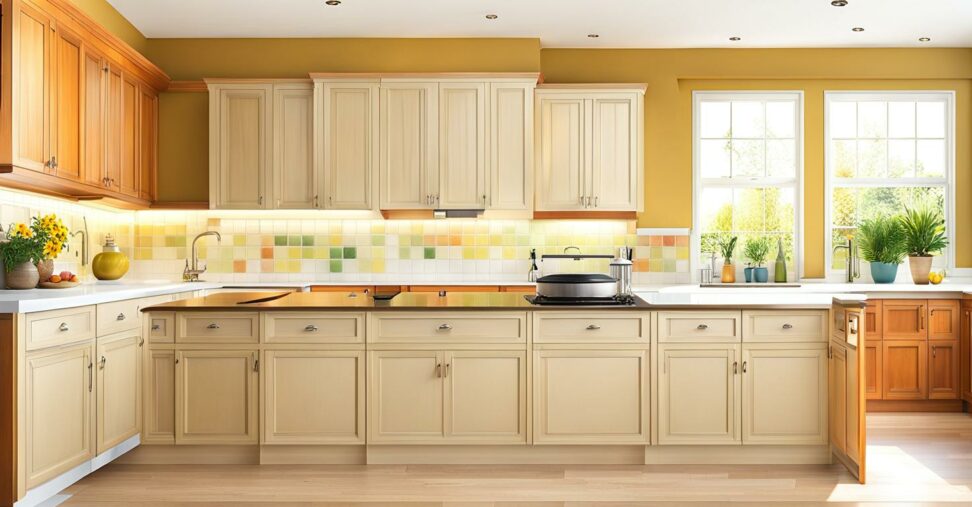Measure Kitchen Cabinets Like an Expert with Our Simple How-To Guide
Installing new kitchen cabinets can completely transform the look and feel of your home's heart. But accurate measurement is crucial for a smooth installation and your dream layout.
Don't stress - with the right tools and techniques, anyone can measure like a pro. This comprehensive guide will walk you through each step.

Why Accurate Measurement Matters
When it comes to installing kitchen cabinets, measuring correctly matters more than you may think. Here's why:
Avoid Costly Ordering Mistakes
Ordering the wrong cabinet sizes or amounts can lead to holes in your layout or unnecessary returns. Taking detailed measurements upfront prevents expensive errors.
Be sure to measure twice and provide your cabinet supplier with exact widths, heights, and any special spacing needs. This ensures you receive the right custom cabinets.
Prevent Installation Issues
Even small measurement mishaps can mean cabinets won't fit the space properly. Installing ill-fitting cabinets leads to gaps, misalignment, and other frustrations.
Careful measurement helps identify potential installation problems so they can be addressed ahead of time. Your contractor will thank you.
Get Your Dream Layout
Precise cabinet measurements allow you to map your ideal layout while planning your kitchen remodel. Playing with different configurations is easier when you know spatial limitations.
You'll also avoid limiting your design for lack of accurate planning measurements. Measure first so your cabinets enhance your kitchen workflow.
Cabinet Measurement 101
Before starting, you'll need to understand a few cabinet basics:
Standard Cabinet Sizes
Most cabinets come in standard widths, heights, and depths:
- Widths: 30", 36", 42"
- Heights: 34 1/2", 84"
- Depths: 24"
Use these as a starting point when measuring your space.
Tools You'll Need
Gather these essential measuring tools:
- Tape measure
- 4' level
- Pencil and paper for notes
Optional extras like a laser measure can further simplify the process.
Account for Imperfect Walls and Floors
Use a level to identify any uneven spots, slopes, or angles on floors and walls. Make notes - you'll need to account for these when ordering cabinets.
A few shims during installation can fix small inconsistencies. But share significant high/low points with your cabinet supplier.
Mapping Your Layout
Before measuring, map out your ideal cabinet configuration:
Mark Appliance Openings
Measure the spaces for appliances like your:
- Refrigerator width and depth
- Stove/cooktop width
- Sink base cabinet width
This prevents surprises once cabinets are installed.
Consider Traffic Flow and Access
Think about how you move through your existing kitchen. Use your layout plan to enhance, not hinder, workflow.
Also ensure cabinets provide comfortable access to appliances, counters, and other features.
Play with Different Configurations
With accurate room measurements, experiment with different cabinet configurations before finalizing your layout.
Adjusting cabinet placement on paper is much easier than after installation. Take your time to get it right.
Measuring Your Space
Now it's time to measure. Be sure to note:
Width and Height
Record the width and height of each wall section where cabinets will go. Measure:
- Wall-to-wall widths
- Floor-to-ceiling heights
This gives the maximum dimensions for each cabinet run.
Windows, Switches, Vents
Measure and mark the placement of windows, switches, outlets, and vents on your layout.
You'll need to accommodate these as you position cabinets.
Plumbing and Electrical
Note any plumbing or electrical fixtures that will impact cabinet placement.
Mark their precise locations to avoid interference once installed.
Ordering Your Custom Cabinets
Accurately measuring your kitchen is the first step. Next:
Find a Reputable Supplier
Do your research to choose a cabinet provider known for quality products and service. They'll help translate your measurements into a perfect order.
Provide Detailed Measurements
Give your supplier all the measurements, notes, and drawings documented above. The more details the better.
Ask questions - don't assume your work is flawless. Good suppliers will guide you.
Choose Cabinet Specs
Finally, pick cabinet materials, hardware, accessories, and other options to complete your order.
Keep lead times in mind if your project is time-sensitive. Custom cabinets take longer.
Preparing for Installation
Once ordered, get your space ready for your beautiful new cabinets:
Clear the Space
Remove existing cabinets, countertops, and appliances from the footprint where new cabinets will install.
Mark Studs
Locate and mark wall studs for securing upper cabinets. A stud finder makes quick work of this step.
Confirm Order Details
Review the final order with your cabinet supplier. Make sure all measurements and specifications align with your needs.
Small tweaks are still possible at this stage if needed.
With the right techniques and tools, you can measure your kitchen like a pro. No guesswork, just your dream cabinets.
Follow this guide to get accurate measurements and kickstart your kitchen remodel. The results will be stunning!